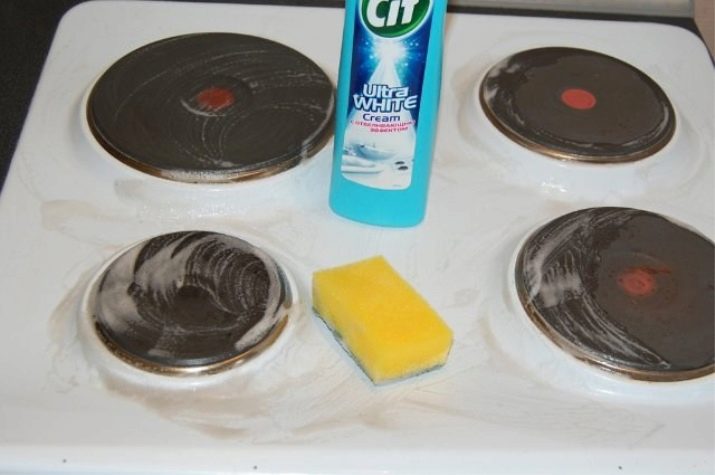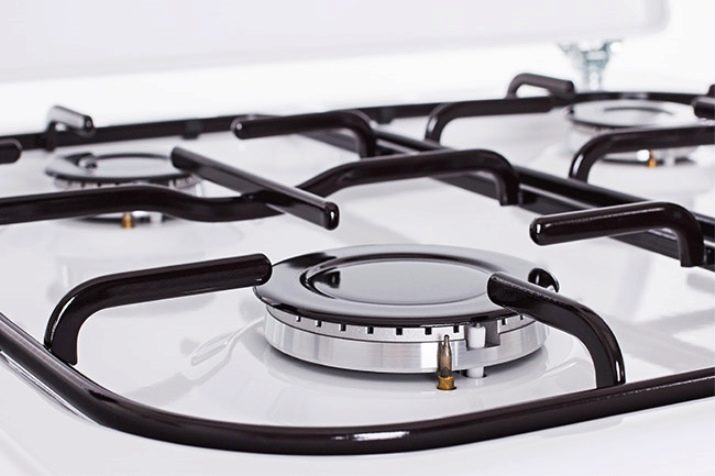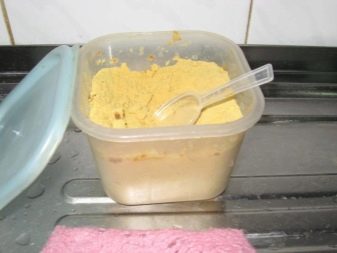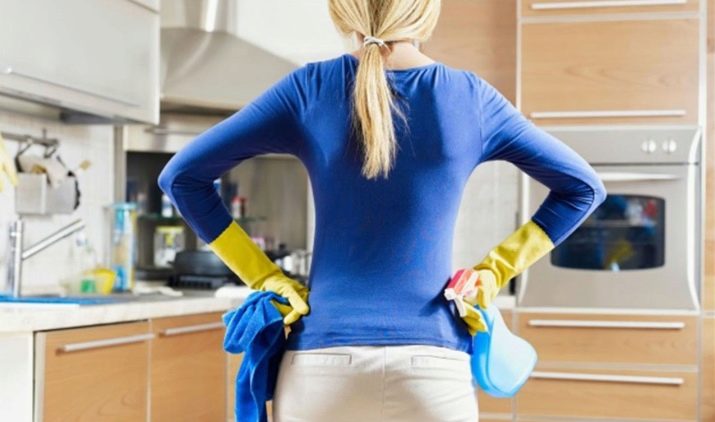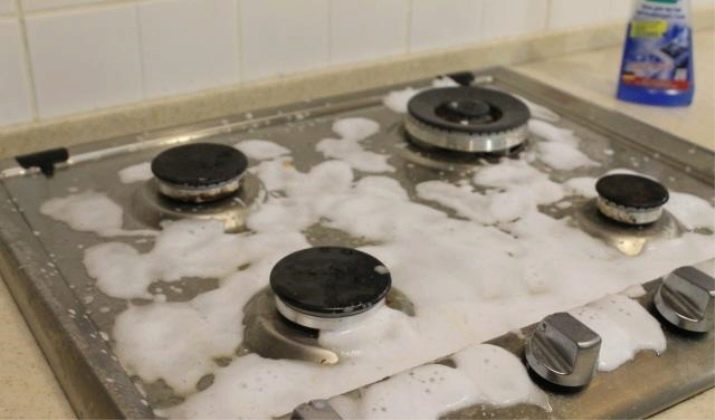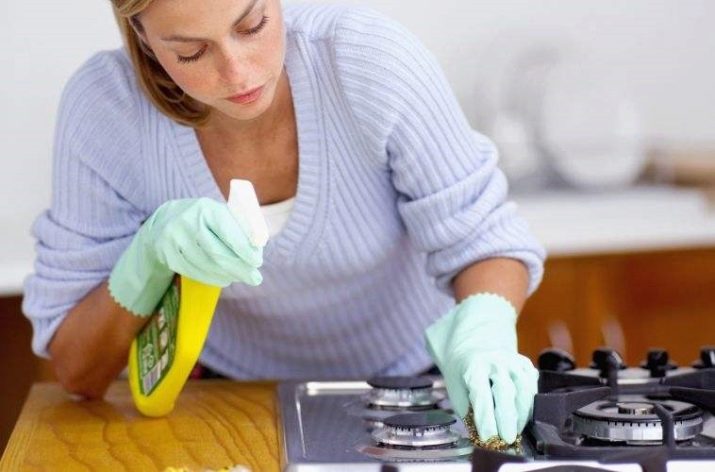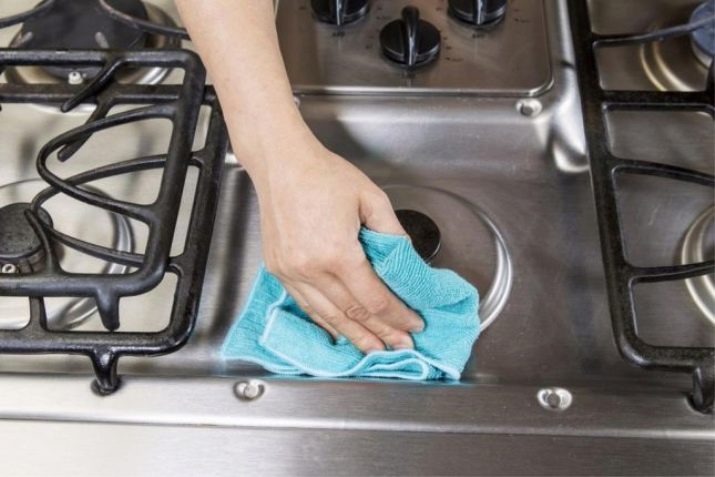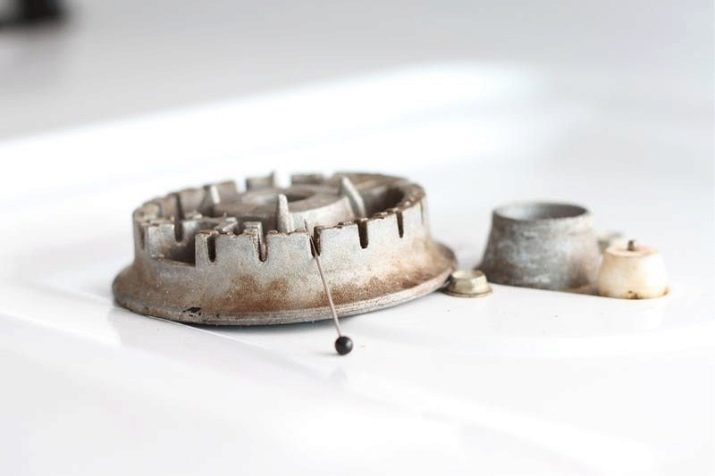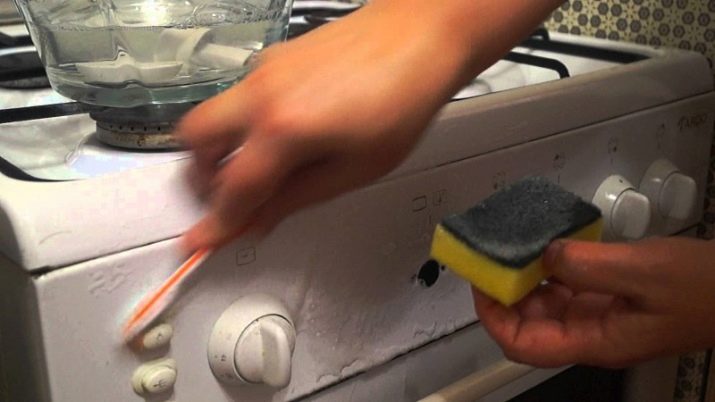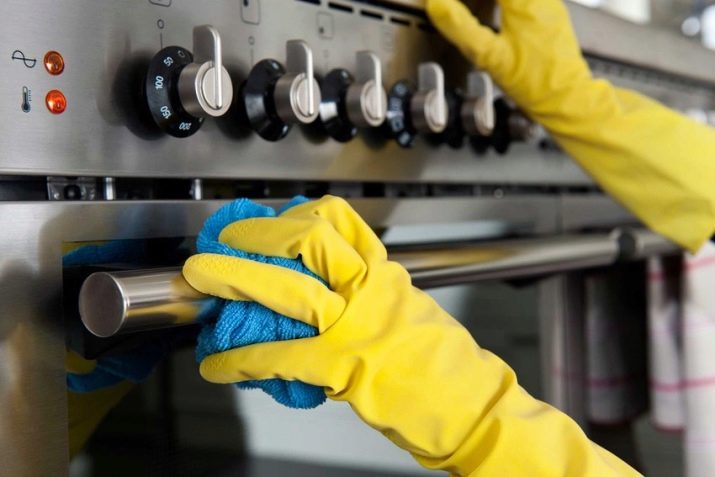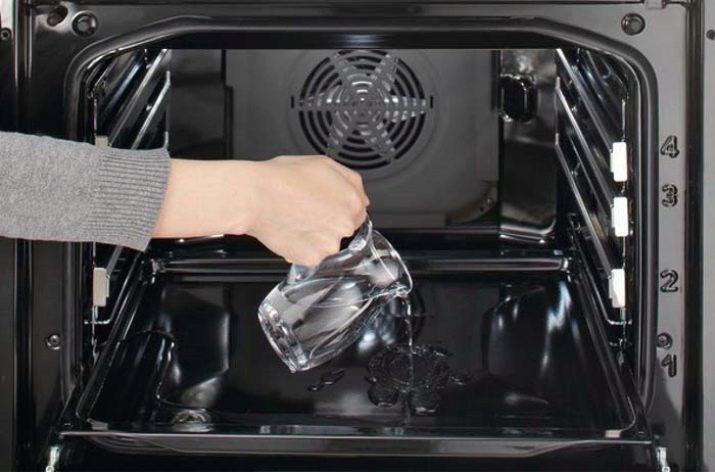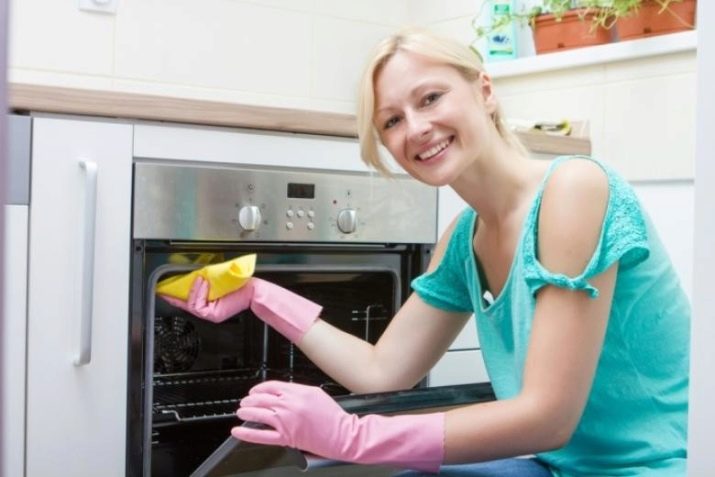How to clean the gas stove from fat?

No matter how careful the hostess is, stains and oil splashes from cooking food inevitably fall on the gas stove. Of course, there is nothing easier than to immediately remove the pollution with a sponge, but there are so many things to do around the house. Sometimes there is simply no time to wash the stove immediately after cooking, and in some cases women get so tired of the day that in the evening they just don’t want to do it. And the next day, you have to solve a new problem - how to clean the surface from already frozen, and sometimes stubborn grease stains. In this article we will consider different ways of cleaning the gas stove and its main parts from fat.
Cleaning features
The choice of means and method of purification directly depends on the material of the cooking surface, but There are several general rules for cleaning gas stoves (some are suitable for electrical appliances):
- The gas stove should be cleaned, especially by commercial means, only with rubber gloves, as these products contain components that can irritate the skin of the hands;
- make sure that the tile has completely cooled down after the last use, otherwise you risk getting burned;
- never need to use a cleaning agent, in the list of active components of which there are aggressive acids;
- Abrasives are absolutely not suitable for this purpose, as they leave a large number of scratches on the slab, due to which the slab stains even more intensely. But soda and mixtures containing it can be safely applied, because this product not only softens the fat, but also absorbs unpleasant odors from burned food;
- do not use metal brushes and very stiff sponges when cleaning, as a strong mechanical impact damages the surface of the plate;
- to clean the fat is much more difficult when it is frozen and absorbed, so washing the gas stove should be a regular exercise, not an emergency. Ideally, this should be done after each cooking process;
- of whatever material the cooking surface is made of, for its cleaning the most suitable are means in the form of pastes, gels or creams, and not powders;
- Before starting work, it is desirable to shut off the gas supply if the gas stove and be sure to disconnect the appliance from the network if the kitchen stove;
- before proceeding directly to the washing, remove the burners, and place a rag in the holes from them, which will prevent liquid from getting inside.
What to use?
There are dozens of ways to clean the slab of fat with the help of available tools. Many popular recipes for such blends include ingredients that are found in virtually every home. This is, above all, soda and vinegar, citric acid and ammonia, mustard powder and baking powder for the dough. And for those who prefer to use ready-made commercial products, the modern market of household chemicals provides a huge selection of effective means for cleaning gas stoves.
Consider the most common of each category.
Folk remedies
Ways of cleaning with improvised means:
- If the fat has appeared recently and has not yet had time to harden, you can remove it with the help of ordinary vinegar (9%). If it is more concentrated, dilute it a little with water. Pour the liquid into a spray bottle and spray it over the entire surface of the gas stove. Wait 15 minutes and remove the dirt with a soft sponge, and then wipe the stove with a wet cloth and wipe dry.
- If the grease stains are already frozen and it is impossible to wipe them off using simple methods, use the help of citric acid. Moisten a little bit of the surface and pour plenty of powder on visible stains. You can substitute citric acid with lemon: squeeze the juice onto a greasy stain and rub it a little with a lemon slice. Now you need to give the tool to dissolve the fat (10-15 minutes), and then easily wipe it off with a sponge or cloth.
- Mix soda and the finest salt in equal proportions (coarse is not suitable, as there is a high risk of scratching the stove), add a little water to make a soft gruel. The resulting mixture rub the greasy surface and rinse with water.
- Very well breaks fat gruel made from dry mustard and a small amount of water. Thoroughly process all covered with fat bloom places, wait 20 minutes, rub a little, then rinse with water.
- If stains are old and there are a lot of them, use a stronger tool. Using a spray bottle, moisten the gas stove with vinegar, fresh lemon juice or citric acid solution. Sprinkle soda over the soiled surface. As a result, a chemical reaction must occur between the acid and alkali, which will help to soften the frozen fat.
In order for the product to work, you need to leave it for 10-15 minutes and only after that wash it off with a sponge.
- Perfectly cope with the fat of ammonia-anisic drops. Add a teaspoon of ammonia to a glass of water, apply to the dirty surface of the plate. After 15 minutes, remove the softened fat with a cloth, rinse off the residue with water and wipe dry.
- In the most neglected cases, some housewives use refined gasoline, wetting the slab soiled with grease and, after 10 minutes, flush it with plenty of water.
- If you have the opportunity to start cleaning in the evening and finish early in the morning, use the following recipe. Prepare a solution of 50 g of rubbed soap and a small amount of hot water. Add 100 ml of vinegar (9%) and 40 g of soda ash. Prepare the mixture with the entire surface of the tile and let it act until the morning. During this time, the fat deposits will loosen and you can remove them almost without effort. Instead of the described mixture, you can prepare a solution of 2 liters of water and 4 tbsp. l salt - just in the evening fill it with a plate, and in the morning complete the process of its purification.
When cleaning the surface of the gas stove from grease, do not forget to wash the upper grate. The method of removing impurities from it will depend on the material of manufacture. If it is cast iron, then the best way in this case is roasting on an open fire, under the action of which all burnt particles of food and fat will fall off by themselves. You can also steam the grill in the oven. The main thing is not to wipe the grate with a damp cloth after this, but simply dry it quickly so that it does not become covered with rust.
Most effectively removes grease from the steel lattice means based on ammonia. It is enough to lubricate the rods with ammonia using a sponge and completely place the grate in a plastic bag. Tie it at least two hours. After that, simply wash under the tap using ordinary dishwashing liquid - the grease and burnt food can easily be washed off the steel bars.
Household chemicals
The above recipes really help to remove fat from the gas stove, but, like all natural products, they have their drawbacks, the main of which is that you have to wait a long time until the product works, and as a result you still have to apply physical effort. Household chemicals - is another matter. Ingredients are included in store formulas to dissolve fat almost instantly, and remove it simply by wiping the plate with a cloth.
All variety of such products can be divided into the following groups:
- Abrasives. These are powders containing abrasive particles.Instructions for their use typically such: the powder is scattered over the entire cooking surface at a period recommended by the manufacturer, after which the fat is physically erased from the plate with a stiff brush, and the residues washed with water means. As already mentioned, the use of abrasives is highly undesirable with regard to gas stoves. The only option when it is justified - the surface of the stainless steel, which is not threatened with scratches.
- Detergents. The structure kremo- and gel products include micro-granules, taking on the abrasive function, but, unlike those in powdered media, they do not scratch the plate. They are applied to a surface slightly moistened with water, and after some time they are rubbed off with a sponge along with dissolved fat. Detergents also include pastes and foams, one of the advantages of which is their ability to hold, not even draining on horizontal surfaces.
- Liposolvent These are concentrated sprays designed specifically to remove grease, so they should not be applied to the entire surface of the plate, but only to grease stains. The exposure time is indicated on the package. Usually, grease solvents clean highly contaminated ovens, grates, handles and burners.
How to clean?
Each of the parts of the gas stove requires a special approach to the removal of fat. Consider how to properly clean the hob hob, its handles, burners, burnt bottom, jets and oven. From the old fat can be cleaned even plastic.
Slab surface
To clean the surface of a plate made of stainless steel or another coating, you must adhere to the following instructions:
- Pull out the burners.
- Using a dry sponge or cloth, remove unburned dirt and food residue from the stove.
- Practically all means (both national, and commercial) are applied on a wet surface, therefore its moistening will be the next stage. This can be done with water, vinegar or citric acid - it all depends on your chosen method of cleaning.
- Apply a grease remover (prepared or cooked by yourself).
- After a set time, rub the stove with a small amount of force with a sponge or soft brush, removing the remnants of burned fat.
- Wipe the surface with a damp cloth, repeat the procedure until it is completely clean.
- Allow the cooker to dry completely or wipe it dry.
- At the final stage, a clean surface can be treated with a polish or ordinary glass liquid.
The areas around the burners should be especially thoroughly cleaned, as they are contaminated the most.
If the heating elements cannot be removed, clean the gaps between them and the stove with a toothpick.
Burners
The main parts of the gas burner are the nozzle, the fire divider and the lid of enameled steel. You can clean the burner with ordinary soap and then rinse with hot running water. If the item is very dirty, it is pre-soaked. When cleaning the burner itself, you cannot use chlorine-containing agents. Apply the selected composition to it and clean it with a small effort with the hard side of a regular sponge, wash and dry.
When you need something more effective, use the following recipe. Make an acetic solution by combining equal amounts of water and vinegar. Put the hotplates in it and boil them for about five minutes. Turn off the heat, but do not remove the burners until the liquid is completely cooled. Clean the parts with a sponge or toothbrush, rinse with warm water and dry.
Do not forget to make sure that nothing prevents the passage of gas through the burners. If any of the holes are clogged, clean them with a toothpick.
Pens
These elements of the gas stove become soiled very quickly, and therefore also require frequent cleaning. To clean the pens from grease and dirt, put them in a regular soap solution for several hours, then wipe with a sponge.If you cannot wait that long, boil the handles in a liter of water with the addition of two tablespoons of vinegar and, after natural cooling, remove the remaining dirt. This procedure allows you to get rid of fat, even in remote places.
If on your stove handles can not be removed and cleaned separately, prepare soda and ammonia, sponge, toothbrush and toothpicks with cotton buds.
Operating procedure:
- Treat the handles with soda applied to the soft side of the sponge.
- Prepare a solution of ammonia (1: 1) and clean them especially difficult places. Focusing on the size of the holes and gaps, use a toothbrush and cotton swabs.
- Let it work and, after 10 minutes, rub the handles again with a clean sponge or brush.
- Clean the most inaccessible places with a toothpick.
Oven
The oven is the place where the fat inside is especially actively accumulated and burned. And it can be very and very difficult to clean. Here are some ways to effectively get rid of fat in the oven.
All the ingredients of this tool are usually present in the locker of any hostess. With it you can clean the oven with an average degree of pollution. Fully free it from all contents - trays, grids, thermometer and other elements, if any.
Prepare a paste from half a glass of baking soda and water and apply it to the entire inner surface of the oven, and especially thickly where there is most fat and scale. Leave for 12 hours. First, use a dry cloth and then a plastic spatula to remove the carbon that has separated from the walls and soda paste. If in some places the fat is not completely removed, sprinkle them with a solution of vinegar (you can use a spray). After reacting with the remains of soda, the liquid forms a foam, which is easily removed by a sponge along with carbon deposits.
To facilitate this process, the sponge can also be moistened with vinegar.
Remove everything except the grill from the oven and heat it to 200 degrees. Pour water into a baking sheet or any container and pour 20 g of citric acid (it can be replaced with highly concentrated vinegar or any dishware). Now place the baking sheet on the lowest level (bowl - right on the bottom).
After about 40 minutes, perspiration will appear on the door - this means that the water began to boil. Turn off the oven and do not open the door for another half hour. After removing the pan or liquid bowl, rub the walls with the hard side of the sponge. In order to remove badly burned grease stains, additionally use soda.
To remove soot from trays and grates, soak them in the bathroom, adding dish liquid, then rub soda using a brush or a hard sponge.
Care Tips
To avoid too much pollution of the gas stove, follow a few simple rules:
- make sure that the flame does not extend beyond the edges of the cookware while cooking;
- make sure that when boiling the liquid do not fill the burners;
- When using the oven, cover cooking dishes with a lid, special paper or foil whenever possible;
- after the dish is cooked, do not leave the dishes with it on the gas stove, use it only for culinary purposes, and not as a stand;
- if you plan to fry something without a lid, you can cover the surface of the stove with foil, after cutting holes for the burners. Some mistresses instead of foil scatter a layer of soda;
- remove all grease stains immediately after they appear, without waiting for freezing.
At home, clean the gas stove from fat is a snap. You just need to follow our advice.
On how to clean the gas stove from fat without chemicals, you will learn from the following video.


